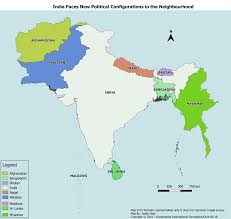India being the centre to disputes with smaller neighbours, it remains a punching bag for all real and imaginary problems arising out of their own domestic fissures
by Prasad Nallapati*
Much of the Indian sub-continent is under the grip of growing nationalist tendencies that are testing the already fragile fault-lines of the region.
In danger are many of the infrastructure and connectivity projects that are jointly launched for collective good and greater economic integration of the region.
Sri Lanka’s tumultuous civil unrest two years ago forced ruling Rajapaksa family to flee the country and bring Anura Kumara Dissanayake, the leader of the Marxist-turned ultra-nationalist party, the Janatha Vimukthi Peramuna (JVP), to power in the just concluded elections.
Bangladesh had similarly seen violent bloodbath that swept the recently re-elected Sheikh Hasina government and installed an economist-led administration sympathetic to Islamist circles.
The latest episode of ethnic violence in Myanmar that erupted following the 2021 coup saw the military junta losing control of much of the country to several ethnic groups, with serious implications for border nations of India, Bangladesh, China and Thailand.
The Mohamed Muizzu’s party rode to power in Maldives on `India Out’ slogan. Nepal and Bhutan too have their own share of pressures though to a different degree.
Although it was all domestic political mismanagement and consequent economic hardships that created the upheavals, a common thread running through all these eruptions is anti-India theatrics as New Delhi is perceived to be close to fallen governments.
India Is Neighbours’ Punching Bag
The outrage against their unpopular governments is often converted into attacks on India and its local interests, particularly Hindu minority community.
Over 200 attacks were reported on Hindus or their properties and at least five killed in recent violence in Bangladesh. Tamils in Sri Lanka are discriminated and have long been the targets of JVP attacks. Although Hindus are not directly attacked in Myanmar, they along with other minorities are treated as `second class’ citizens and their businesses are targeted.
Part of the problem lies with British colonial legacy of shifting populations to labour their enterprises of economic exploitation and a series of incomplete and insensitive partitions.
Separation of Myanmar in 1937, creation of Pakistan in 1947 and independence of Bangladesh in 1971 left many scars of artificial borders dividing families and similar ethnic groups and posing recurring problems for local inhabitants as well as frontier security agencies.
There is thus much unfinished work of these legacies which continue to plague the sub-continent. Disputes are so intricate for any easy resolution. Stroking of popular passions by local parties make their resolution even more complicated.
India being the centre to all these disputes with the smaller neighbours, New Delhi remains a punching bag for all real and imaginary problems arising out of their domestic fissures. Attempts by foreign powers, like China, the US and the UK, to undermine India’s natural influence and promote their own are only aggravating the conflicts.
Efforts to Promote Regional Economic Integration
The `Neighbourhood First’ and the `Act East’ Policies, enunciated by the Modi government, have the larger objective of promoting hassle free connectivity among sub-continental states and promote regional economic integration. Ambitious plans are underway for greater connectivity to India’s North-eastern region through Bangladesh and Myanmar and integrating them with ASEAN countries beyond.
The Kaladan Multi-Modal Project (KMPP) aims to improve connectivity to India’s North-east region via Bangladesh and Myanmar, linking India’s Kolkata port to Myanmar’s Sittwe port and extending to Mizoram through highways in Myanmar.
The India-Myanmar-Thailand Trilateral Project (IMTTP) connects India’s border town, Moreh, to Mae Sot in Thailand via Myanmar, establishing a land route for seamless trade, business, education and tourism among all three countries.
These projects, though largely completed on Indian and Thailand sides, face an uncertain future in Myanmar as the regions through which they pass are wrested control by various ethnic armed organizations such as the Chin and Arakan Army, with the ruling junta now restricted to much smaller area around the Capital, Naypyidaw.
Bangladesh granted India full access to both the Chittagong and Mongla ports for building additional terminals to promote transit and cargo shipping. India’s Adani and Hiranandani groups were separately awarded contracts to develop two special economic zones (SEZs) near to these ports.
In addition, six rail and road projects are underway in Bangladesh, financed by India. Work on the Khulna-Mongla Rail Line has been completed. Expansion of Dhaka-Tongi and Tongi-Joydebpur routes for additional lines is in progress to improve capacity of vital sections that connect the capital with country’s rail network.
Other projects are Kulaura-Shahbazpur section; conversion of the metre-gauge into a dual gauge line from Parbatipur to the Kaunia section; construction of double line in the Khulna-Darshana section; and construction of dual gauge line from Bogura to Sirajganj.
Two of the road projects are widening of the 51 km route connecting the Ashuganj river port to the Akhaura land port to four lanes and building of a 50km 4-Lane National Highway from Cumilla’s Mainamati to Brahmanbaria’s Dharkhar.
Five Indian power companies are supplying electricity to Bangladesh to cover its severe short fall. Adani Power is the largest provider, which supplies electricity from its 1.6 GW coal-fired plant in Godda, Jharkhand, through a dedicated transmission corridor. SEIL Energy India supplies 740 MW of power, PTC India 250 MW and the balance by Power Grid Corporation of India.
Dacca owes over $ 1 billion in dues to these companies, out of which $800 million to Adani Power itself.
In Sri Lanka, Adani Group is also developing the western terminal of the Colombo port with an investment of $650 million of which $553 million is financed by a US Agency. The terminal is set to ease the congestion at the eastern terminal, which has been the hub for transshipment of Indian cargo. The first phase of the project is to be completed this year and the second next year.
The Group also secured a 484 MW Wind Power project costing about $740 million but is mired in courts. Newly elected President Dissanayake of the JVP had declared that the project would be reviewed and scrapped if the cost is found excessive.
Way Forward
Political changes in the region have created uncertainties over India’s ambitious plans for greater connectivity in the East and in the Indian Ocean region for closer economic integration and to defeat evil designs of foreign powers like China.
Such challenges are, however, not new to Indian diplomacy. A quiet, patient, and persuasive diplomacy has proven to soften momentary passions in the neighbourhood. Indian investments and financial aid have helped the neighbouring countries survive economic hardships created by internal mismanagement and Chinese debt burden.
The young leadership that emerged in these countries is in a hurry to meet popular expectations of creating jobs and economic growth. As they settle down, it dawns on them the realities of economic inter-dependencies in the region, which cannot be replaced by expensive foreign debts.
India swiftly extended a lifeline to Sri Lanka to come out of its unprecedented economic turmoil with liberal assistance of over $ 4 billion, surpassing even the IMF’s 48-month bailout of about $ 3 billion.
At the request of Maldives, India last week extended emergency financial support by subscribing to its $ 50 million treasury bill to avert its debt default. State Bank of India took a similar $50 million treasury bill subscription in May. India has also extended repayment deadline for $ 150 million of the $200 million debt.
New leaders of both Sri Lanka and Maldives, Dissanayake and Muizzu, who had held anti-India stance are now appreciative of Indian gestures and expressed interest in expediting projects financed by New Delhi. Bangladeshi administration too has requested India to take its projects forward swiftly as they are beneficial to the country.
Myanmar crisis is much more complicated and require enormous patience. New Delhi has so far limited its contacts to the military junta as they were helpful in fighting Indian insurgent groups in the North-eastern region.
With ground realities changing, India may be better served by opening lines of communication with new masters of Myanmar’s border regions to further mutual interests and thwart Chinese expansion.
In the meantime, India will have to hold back many of its ambitious connectivity projects which is really a serious set back to Modi government’s `Neighbourhood First’ and `Act East’ policies.
Pakistan is deliberately not discussed in this paper as it considers itself a separate class, an antithesis to the idea of India. Its ruling establishment place it a part of the Islamic world of the West Asia and nothing to do with the subcontinent except to reign over it. The region will have real peace the day Rawalpindi come to grips with reality.
(*Prasad Nallapati is President of the Hyderabad-based think-tank, “Deccan Council for Strategic Studies”, and former Additional Secretary to Govt of India)




